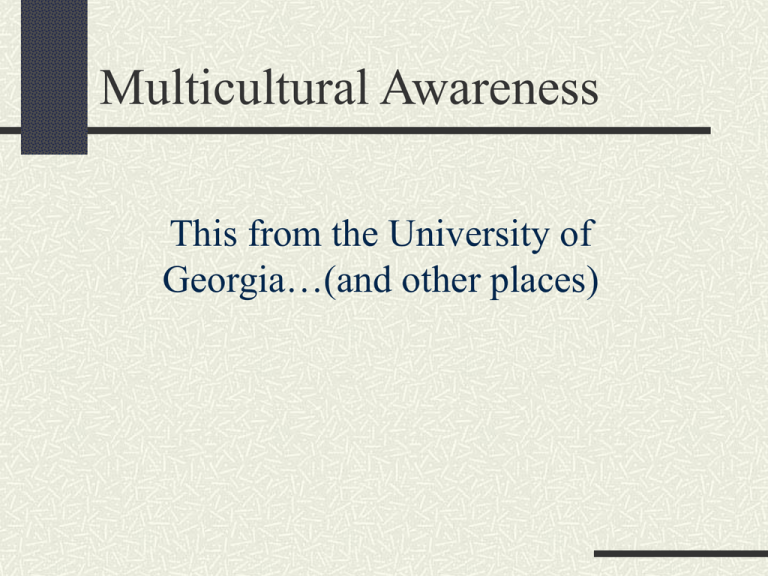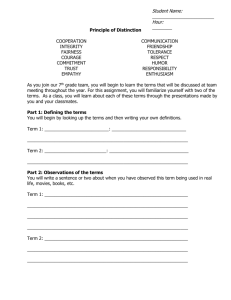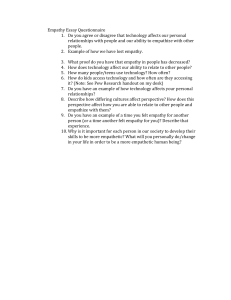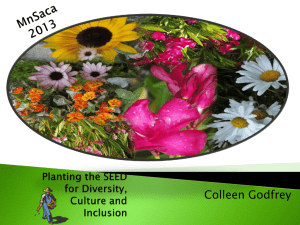Multicultural Awareness Quiz
advertisement

Multicultural Awareness This from the University of Georgia…(and other places) Look at this picture: •What are your perceptions about Asian-American students? •What are your beliefs about their intelligence in comparison to yours? •Where do you think AsianAmerican students spend most of their time in college? •Where do you think this student is from? Look at this picture: •What do you think about interracial dating? •Should people date only within their own race? •What problems do you think this couple will face in society? •How would you react to seeing this couple in public? Look at this picture: •What is your perception of this group of men? •Do you think these men are exclusive in socializing with their own race? •Do you think they believe themselves to be superior to other races? •What do you think the social life of these men comprises of? Look at this picture: What is your perception of this athlete? What do you think is her primary purpose for attending the University of Georgia? What do you think her social life consists of? How do you think this student performs academically? Some Terminology: RACE A category of people identified on the basis of similar visible physical characteristics. CULTURE The customs, ideas, skills, arts, etc of a given people in a given period and /or location. ETHNIC GROUP A group with which individuals are identified, or with which they identify themselves, on the basis of cultural characteristics. MINORITY A smaller part of a population differing from others in some characteristics and often subjected to differential treatment. Some Terminology: DISCRIMINATION A showing of partiality or prejudice in treatment, specific action, or policies directed against the welfare of minority groups. PREJUDICE A judgment or opinion formed before the facts are known; Suspicion, intolerance, irrational hatred, condemnation, or disapproval of other races, creeds, cultures, etc. Empathy Empathy is "putting yourself in someone else's shoes." By this we mean considering how another person might think or feel in a specific situation. Empathy also involves looking at your own behavior from the other person's point of view. Ways to promote diversity using empathy include: • Listen to things people say and see the merit in other opinions • Notice your body language • Don't interrupt others; this will help you listen to their opinions Understanding This skill is closely related to using empathy, but involves more of a process of critical self-evaluation and reflective thinking. Think of some ways in which your values, ideas, and attitudes may lead to or highlight prejudice. Try to equate the relationship between your patterns of thinking and patterns of behavior. Ways to promote diversity using understanding include: • Disregard commonly help stereotypes • Examine your behavior and communication patterns when interacting with people different from yourself Awareness This skill encourages conscientiousness, not only in being mindful when interacting with others, but also in acknowledging, respecting, and being open to ideas and differing points of view. The more that knowledge is acquired about the issues relating to race and diversity, the less an individual will see alternative cultures as a threat to one's own culture or identity. Ways to promote diversity using awareness include: • Get to know persons from races and cultures than yours • See movies and read periodicals involving other races or cultures • Ask questions! Do not be afraid to clear up any aspect of a person's culture you do not understand • Attend a multicultural event or program on campus • Attend a cultural training seminar or workshop on campus Recognizing Consequences Every action or behavior has a consequence, either positive or negative. Prejudice and discrimination have negative consequences for all parties involved. Think about how your behavior might affect those people you interact with. Not only can your actions have consequences, but your lack of action can have an impact on others as well. Ways to promote diversity using consequences include: •Avoid telling and laughing at racist jokes •Use words that are politically correct and do not offend anyone •Sponsor activities that bring people together for an educational and learning experience Fairness Fairness is eliminating one's opinion and prejudices in order to achieve a balance of different interests. It is the belief in an action toward establishing and promoting equality among people. Being genuine is a necessary component of promoting fairness. Fairness also demands that laws protecting individuals are respected and followed and that people are treated as individuals. Ways to promote diversity using fairness include... •Offer the same opportunities to everyone •Treat everyone with the same dignity and respect Behaviors and Strategies for Teaching Diverse Students Appreciate an accommodate similarities and differences Build relationships with all students Watch your students and focus on how they learn More Behaviors and Strategies… Vary your methods and activities Consider culture when planning Include affective objectives Communicate expectations and rationales Use advanced organizers and closure to the lesson Review Be fluent and efficient in transitions Monitor Give feedback • Require mastery!






